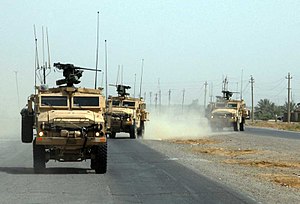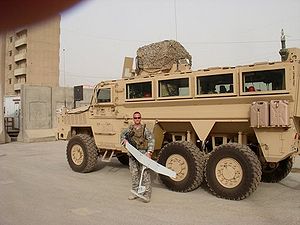RG-33
| RG-33 (standard four wheel variant) | |
|---|---|
 | |
| Place of origin | |
| Service history | |
| In service | 2007-Present |
| Used by | USMC US Army |
| Wars | Iraq war, Afghanistan war |
| Production history | |
| Designer | Land Systems OMC |
| Manufacturer | BAE Systems Land Systems South Africa |
| Unit cost | $300,000 |
| Variants | RG-33 (4x4) |
| Specifications | |
| Mass | 14.0 t |
| Length | 22.1 feet (6,700 mm) |
| Width | 8 feet (2,400 mm) |
| Height | 9.5 feet (2,900 mm) |
| Crew | 4 + 2 crew |
| Armor | monocoque v-hull |
Main armament | Optional armored glass turret or remote weapon station |
| Engine | Cummins 400 I6 Diesel 400hp |
| Transmission | Allison 3200 |
| Suspension | 4x4 Double wishbone suspension |
| Ground clearance | 14 inches (360 mm) |
| Maximum speed | 68 miles per hour (109 km/h) |
| RG-33L (six wheel extended variant) | |
|---|---|
 | |
| Service history | |
| Used by | USMC US Army |
| Wars | Iraq war |
| Production history | |
| Designer | Land Systems OMC |
| Manufacturer | BAE Systems Land Systems South Africa |
| Unit cost | $630,000 |
| Produced | October 2006 (RG-33L)[1] |
| Variants | RG-33L (6x6) |
| Specifications | |
| Mass | 24 t |
| Length | 28 feet (8,500 mm) |
| Width | 8 feet (2,400 mm) |
| Height | 9.5 feet (2,900 mm) |
| Crew | 8 + 2 crew |
| Armor | monocoque v-hull |
Main armament | Optional armored glass turret or remote weapon station |
| Engine | Cummins 400 Turbo Diesel 400hp |
| Transmission | Allison 3200 |
| Suspension | 6x6 Double wishbone suspension |
| Ground clearance | 14 inches (360 mm) |
| Fuel capacity | 80 gal |
| Maximum speed | 67 miles per hour (108 km/h) |
The RG-33 is a mine-resistant light armored vehicle initially designed by BAE Systems Land Systems South Africa (formerly Land Systems OMC) a South African subsidiary of BAE Systems. BAE Systems in the US extensively modified it with additional protection, new power train and suspension systems. It was built in a number of locations including York, Pennsylvania, USA. It is one of several vehicles being fielded by the US Armed Forces in Iraq under the MRAP program.
Overview
It is based on the RG-31, which itself is based on the Mamba APC, although it is roughly twice the weight of an RG-31. There are two variants, the standard RG-33 has four wheels and weighs 22 tons while the extended RG-33L variant has six wheels, can carry twice as many people in the back, and weighs 26 to 37 tons depending on the version.
It was selected to be the sole producer of the US Army's $2.88 billion Medium Mine Protected Vehicle program.[2][3] The initial contract is worth $20 million. BAE representative Doug Coffey says that live-fire testing at Aberdeen, Maryland, proved the RG-33 to be the overall most survivable MRAP vehicle.[4]
The RG33 is manufactured in several configurations including the category I 4×4, category II 6×6, the heavy armored ground ambulance (HAGA) and the special operations command (SOCOM) vehicle.[5]
Design
It features a monocoque armored v-hull, for maximized interior space, seats and footrests suspended from the ceiling, run-flat tires, and an optional armored glass turret (Gunner Protection Kit or GPK), for maximized visibility and protection. The monocoque hull does not extend under the engine like some other armored vehicles. Like the ATF Dingo, the RG-33 uses a Unimog chassis.[6] Unlike the Dingo, the hull and chassis are combined into one unit to provide less space for expansion gases to form.[6] The vehicle is notable for its extensive use of TRAPP armored glass in the crew compartment. Like the Buffalo, it can be equipped with a robotic arm.
The U.S. has fielded 259 RG-33 4x4 variants in a Special Operations Command (SOCOM) configuration as shown above with remote weapon stations, two extra seats, and a rear door assist.[7] The U.S. has also fielded 16 RG-33L 6x6 variants in a Heavy Armored Ground Ambulance (HAGA) configuration.[8]
The Pentagon has future plans to add the Crows II remote weapon station, Raytheon Quick Kill active anti-RPG system, Boomerang anti-sniper system, and the Frag Kit 6 anti-EFP armor.
Production history
- On 26 January 2007, four (2 of each variant) RG-33s were delivered to the United States Marine Corps for testing.
- On 14 February, an order for 15 MRAP Cat 1 RG-33s and 75 MRAP Cat 2 RG-33Ls was placed under an Indefinite Delivery, Indefinite Quantity contract.[9]
- On 28 June, BAE received a $235.8M order for 16 RG-33 Cat 1 patrol vehicles, 239 RG-33L Cat 2 vehicles, 170 RG-33 Cat 1 variants for the United States Special Operations Command, out of their total allotment of 333 vehicles, and 16 RG-33L Cat 2 Ambulance variants, which are the first vehicles in the competition specifically listed for the ambulance role.[9][10] The vehicle can be mission configured for a number of roles including Infantry Carrier, Ambulance, Command and Control, Convoy Escort and Explosive Ordnance Disposal. On 18/Oct, an additional order for 600 MRAPS was received, involving 399 RGL-33L Cat 2, 112 RGL-33L Cat 2 Ambulance variants and 89 RG-33 SOCOM for 322 Million dollars. On Dec/18/07 a further order for 600 RG-33L Cat 2 was awarded to BAE Systems, for 645 Million dollars. To date, this gives a total of 1,735 RG-33 vehicles being ordered by the US Military.
- RG-33 (4×4)
- RG-33L (6×6)
Operators
See also
- MRAP- U.S. Marine Corps Mine Resistant Ambush Protected Vehicle Program
- Medium Mine Protected Vehicle- The U.S. Army Equivalent to the MRAP Program
- List of AFVs
- Buffel
- Casspir
- Mamba APC
- RCV-9
- RG-12
- RG-19
- RG-31
- RG-32
- RG-34
- RG-35
- Pindad Panser - ANOA 6X6 APS
References
- ^ BAE SYSTEMS North America: News and Information: News Releases
- ^ BAE Systems - AUSA 2008 - RG33 Series Mine Protected Vehicles
- ^ 'Panther' designed to keep troops safer
- ^ Diversity Adds Depth to MRAP
- ^ Army Technology: RG33 Mine-Resistant Ambush Vehicle (MRAP)
- ^ a b Defense Review First Look: BAE Systems RG33 Series MRAP Vehicles
- ^ SOCOM variant
- ^ HAGA Variant
- ^ a b c BAE’s Diverse MRAP Orders
- ^ BAE’s Diverse MRAP Orders - Defense Industry Daily
- ^ "US Marines order 90 SA vehicles". 2007-02-20. Retrieved 2007-02-20.
External links
- http://www.baesystemspresskit.com/ausa2007/RG_33_Series.cfm (membership required to access/view)
- Deagel.com: RG-33
- Army Technology: RG33 Mine-Resistant Ambush Vehicle (MRAP)
